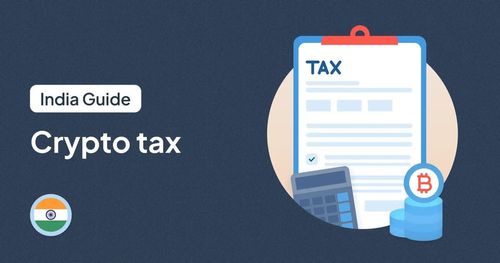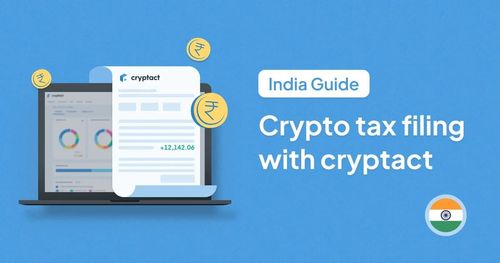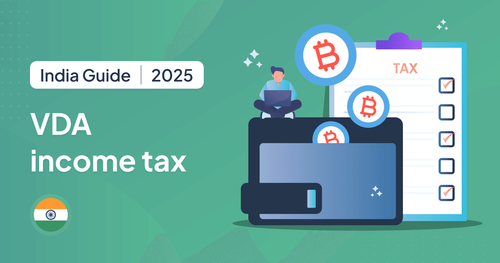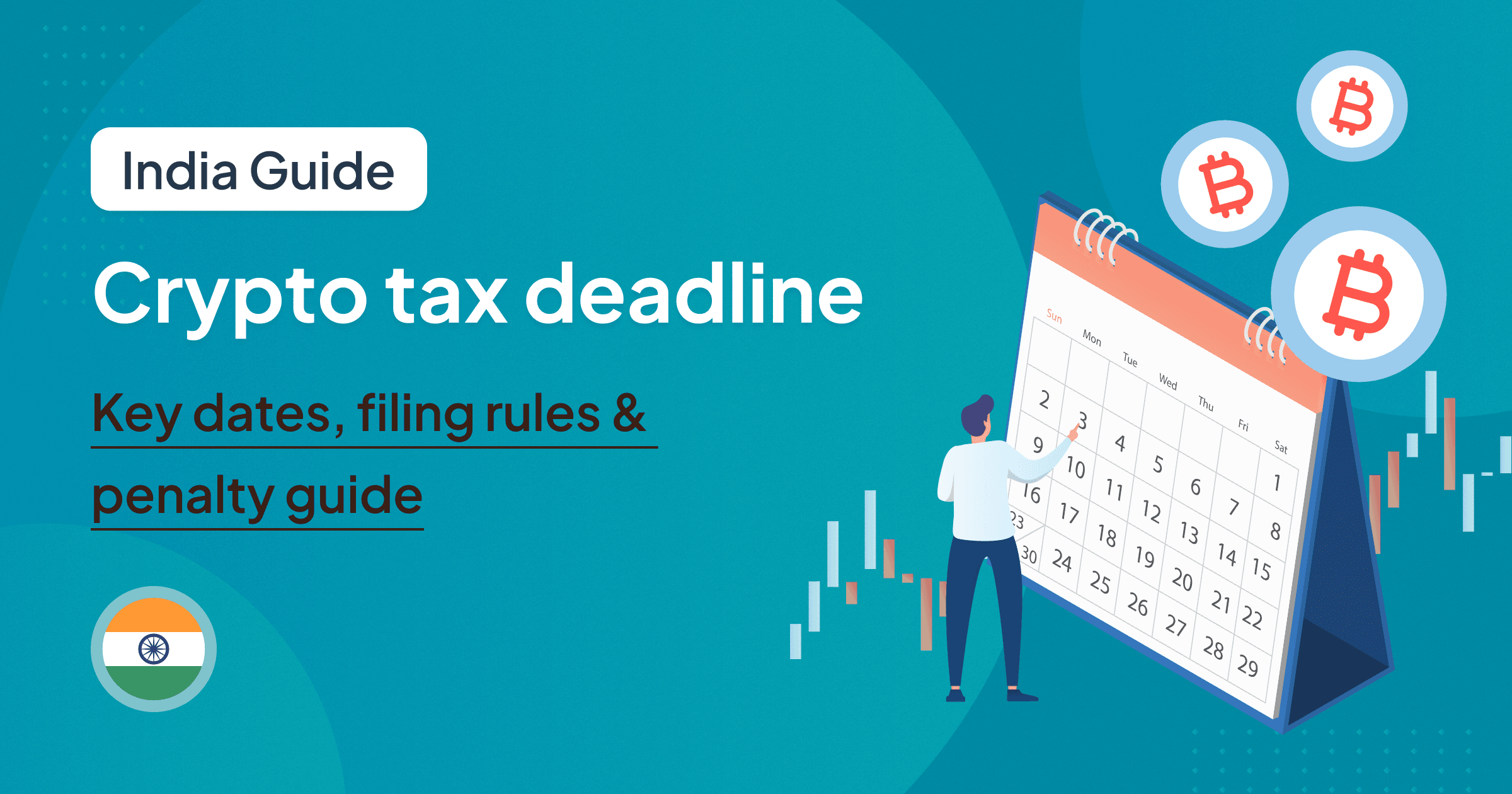
If you trade or invest in cryptocurrency in India, you must report your profits and pay tax on them. It’s important to know the key crypto tax deadline in India to avoid penalties. Below is a simple guide to the major deadlines, tax rules, filing steps, and consequences if you miss the dates.
If you’re looking for a more in-depth dive into VDA rules, check out our article here: Income Tax India 2025: Complete Guide to Crypto Tax Rules, Sections & Filing Process.
Table of contents |
Major Deadlines for Crypto Tax in India
In India, crypto tax filing follows the same calendar as regular income tax. The table below outlines the major deadlines (the crypto tax filing deadline, payment dates, etc.) for reporting crypto or VDA (Virtual Digital Asset) income:
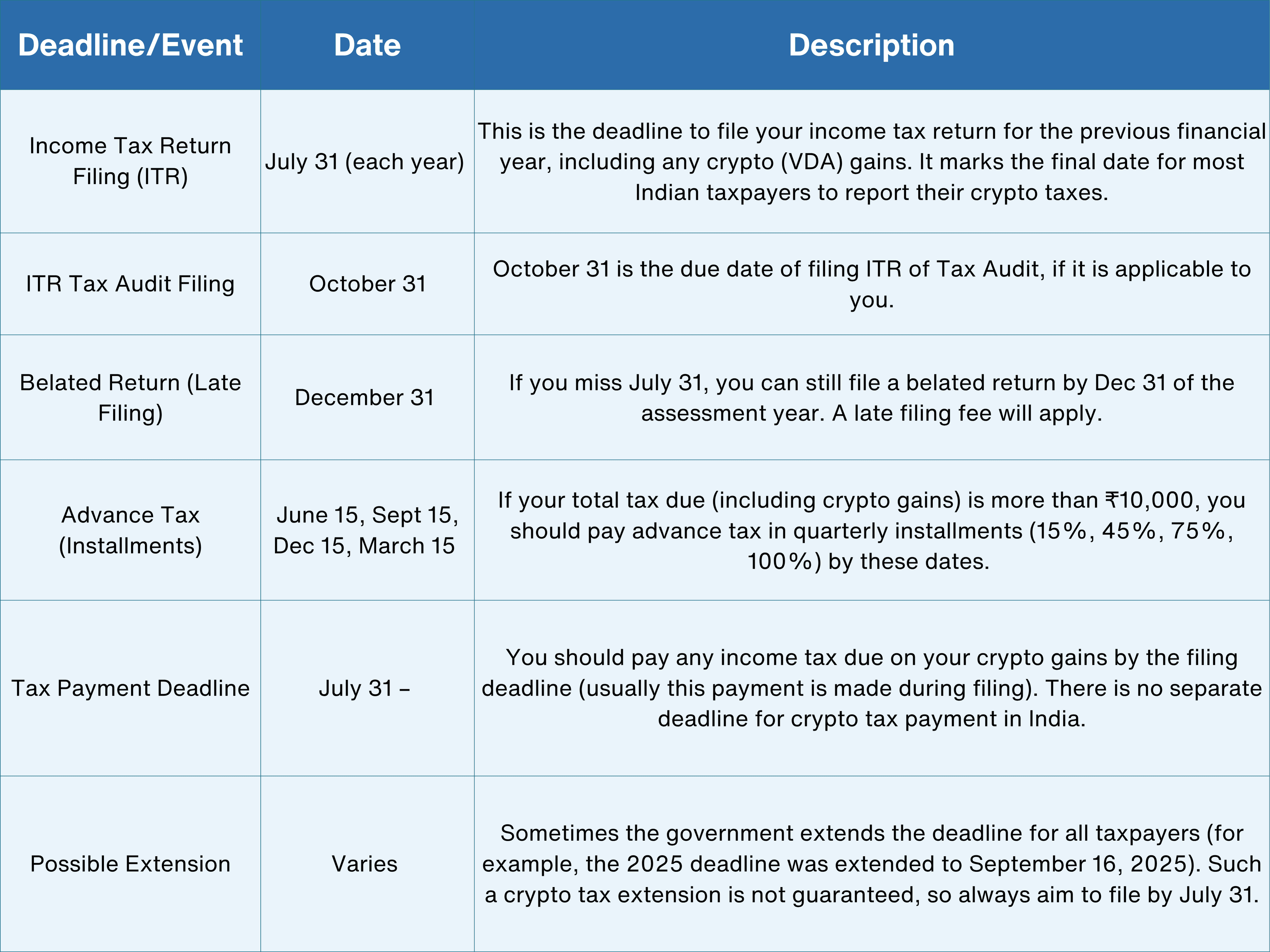
The income tax deadline in India is the same as above for crypto earnings – there’s no special date just for crypto. In other words, the VDA tax filing deadline aligns with the standard tax filing timeline. Always double-check the exact deadlines each year on official sources.
Key Crypto Tax Rules in India
The government of India introduced specific tax rules for cryptocurrencies (VDAs) from 2022 onwards. Here are the key crypto tax rules you should know:
- 30% Flat Tax on Profits: All profits from the transfer of crypto assets are taxed at a flat 30% rate. For example, if you made a profit of ₹50,000 by selling crypto, about ₹15,000 of that will go as tax.
- 1% TDS on Transactions: A Tax Deducted at Source (TDS) of 1% is levied on every crypto transaction’s value (above certain minimal thresholds). This means if you sell or trade crypto, 1% of the amount is deducted and reported to the tax department. You can later claim this TDS amount as tax paid when filing your return.
- No Loss Set-Off: Crypto losses cannot be used to offset crypto gains or any other income. For instance, if you lost ₹10,000 on one coin and gained ₹20,000 on another, you still pay 30% tax on the ₹20,000 gain. You cannot subtract the ₹10,000 loss from it. Also, you can’t carry forward crypto losses to the next year. Essentially, each year’s crypto profits are taxed on their own, and losses are ignored for tax purposes.
- No Deductions Except Cost: You cannot deduct any expenses related to crypto trading (like exchange fees, electricity, etc.) from your gains. Only the cost of acquisition can be subtracted from the selling price to determine your profit.
- Crypto Gifts are Taxable: If you receive crypto as a gift (for example, a friend sends you some bitcoins for free), it is considered taxable in your hands if the value exceeds ₹50,000 in a year (general gift exemption limit). The gifted crypto’s fair market value is treated as “income” for the receiver and taxed at 30% like other crypto gains upon disposal of crypto gifts.
How to File and Pay Crypto Tax in India
Many people wonder how to file crypto tax before deadline in India and how to pay crypto tax. The process is much like filing any income tax return, with a few crypto-specific steps. Here’s a simple step-by-step guide:
- Calculate Your Crypto Income: First, sum up all your crypto gains for the financial year (April 1 to March 31). Calculate profit for each trade = Selling price minus Purchase cost. Ignore any losses for tax (you still note them for your record, but they won’t reduce your taxable gains due to the no-offset rule). For example, if you bought a coin for ₹10,000 and sold it for ₹15,000, your gain is ₹5,000. You can also use tools like cryptact to automatically track your trades, calculate profits, and generate reports for tax filing.
- Log in and Choose ITR Form: Go to the Income Tax e-filing portal and log in with your PAN. Start filing a new Income Tax Return for the applicable year. Choose the correct ITR form, typically ITR-2 (for individuals with capital gains) or ITR-3 (if you have business income) will be needed for reporting crypto.
- Fill in Schedule VDA for Crypto: In the ITR form, you will find a specific section called Schedule VDA (Virtual Digital Assets) to report crypto transactions. Declare your crypto profits here. You may need to provide details of each trade or a summary. Enter the selling price and purchase cost for each asset or transaction as required. The form will automatically apply the 30% tax rate on your net crypto gains. (This special schedule was introduced from AY 2023-24 onwards to ensure crypto is reported separately.)
- Pay the Tax Due: After filling out all income details, the software will calculate your tax. If you owe additional tax (called self-assessment tax), you should pay it before submitting the return. You can pay online through the e-filing portal using a payment challan (Challan 280). Once you pay, you will get a receipt (challan number) which you must enter in the return form to confirm the payment. Essentially, this is how to pay crypto tax India: directly to the government via the online tax payment system.
- Submit and Verify the Return: Complete any other sections of the ITR and review everything. Submit your return before the deadline. After submission, don’t forget to e-Verify the return (using Aadhaar OTP, etc.) as this step is required to complete the filing. Once verified, your return is considered filed. Save the acknowledgment receipt (ITR-V) for your records.
Penalties for Missing the Deadline
So, what happens if you miss crypto tax deadline in India? In short, you could face fines and interest charges. Here are the main consequences of missing the deadline:
- Late Filing Fee: If you file your income tax return after the due date (July 31), you’ll be charged a late fee. This fee is added to your tax and you must pay it when filing a belated return (by Dec 31).
- Interest on Tax Due: In addition to the flat late fee, if you owe any tax that wasn’t paid by July 31, interest will be applied. The law imposes interest at 1% per month (or part of a month) on the pending tax amount from the due date until the date you actually file and pay.
- Possible Notices or Penalties: The tax department is tracking crypto transactions closely. If you don’t report your crypto income at all, you might receive a notice asking for an explanation (since exchanges report big transactions). Continued non-compliance can lead to higher penalties.
Stay compliant with rules and dates, and you’ll have no issues with crypto taxes. It feels good to be on time – you can then focus on your investments without tax worries. Happy filing!
Conclusion
Filing crypto taxes in India is straightforward if you follow deadlines and rules carefully. Track all transactions, calculate gains accurately, and file on time to avoid penalties! The crypto tax late filing penalty India can hit your wallet and the longer you delay, the more you may have to pay.
Tools like cryptact simplify reporting and calculation, ensuring compliance with minimal effort. Start using cryptact today to streamline your crypto tax filing.



